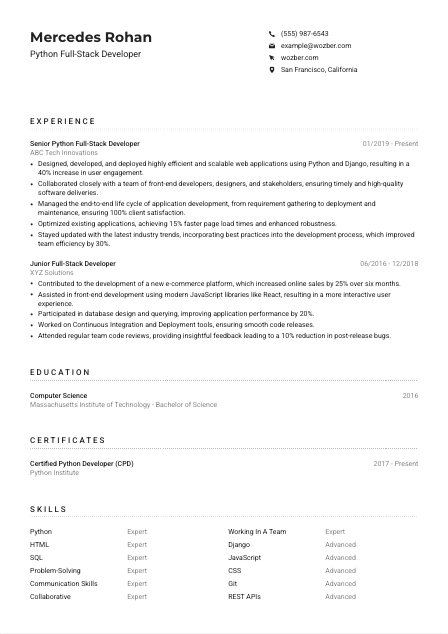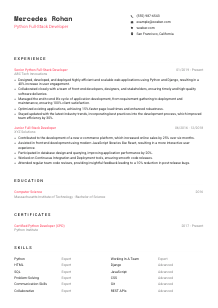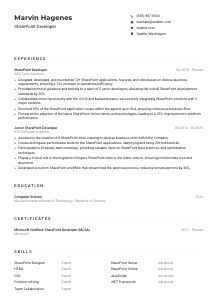Python Full-Stack Developer Resume Example
Juggling Python and stacks, but your resume feels like running into a syntax error? Navigate this Python Full-Stack Developer resume example, constructed with Wozber free resume builder. See how effortlessly you can align your full-stack fluency with job specifics, scripting a career bound to execute to perfection!

How to write a Python Full-Stack Developer Resume?
As a budding Python Full-Stack Developer, your resume isn't just a document; it's a gateway to your future career. With the tech industry's competitive landscape, standing out is paramount. By utilizing Wozber's free resume builder, this guide will navigate you through tailoring your resume meticulously to mirror the job you're aspiring for. Grasp this opportunity to sculpt your resume into a powerful narrative that not only meets but surpasses job expectations.
Ready for this journey? Let's code your way to a standout Python Full-Stack Developer resume!
Personal Details
The Personal Details section is your digital handshake. It's crucial to make this introduction as impactful as possible, ensuring every detail is in sync with what a Python Full-Stack Developer position mandates. Here's how to perfect this section to get a head start.
1. Boldly Brand Your Name
Your name isn't just an identifier; think of it as your personal logo at the top of your resume. Choose a clear, professional font that makes your name pop out, setting a tone of confidence right from the start.
2. Be Explicit with Your Title
Positioning the job title directly beneath your name acts like a headline, telling the hiring manager at a glance what role you're targeting. For specificity, "Python Full-Stack Developer" immediately aligns you with the job's expectations.
3. Make Contact Effortless
Ensure your contact information is up-to-date and typo-free. A professional email address that uses your name is non-negotiable. Plus, listing your city and state confirms your proximity or willingness to relocate, addressing a key logistical question upfront.
4. Web Presence as Your Portfolio
Including a link to a professional profile or portfolio showcases your projects and expertise in Python. This not only solidifies your candidature but also gives hiring managers a sneak peek into your coding finesse and problem-solving prowess.
5. Privacy Matters
Skip over personal information that's not pertinent to your professional qualifications. This not only keeps the focus on your skills and experiences but also helps in maintaining privacy and professionalism.
Takeaway
Imagine your Personal Details section as the doorway to your professional journey. It's more than just data; it's your introduction to the world of Python Full-Stack Development. Ensure it's polished, precise, and aligns seamlessly with the job you're eyeing. It's your first impression, make it count!





Experience
Your Experience section is the backbone of your resume. This is where you prove, with concrete evidence, that you're not just familiar with Python Full-Stack Development, but you've also excelled in it. Let's break down the steps to tailor your experiences like a pro.
- Designed, developed, and deployed highly efficient and scalable web applications using Python and Django, resulting in a 40% increase in user engagement.
- Collaborated closely with a team of front‑end developers, designers, and stakeholders, ensuring timely and high‑quality software deliveries.
- Managed the end‑to‑end life cycle of application development, from requirement gathering to deployment and maintenance, ensuring 100% client satisfaction.
- Optimized existing applications, achieving 15% faster page load times and enhanced robustness.
- Stayed updated with the latest industry trends, incorporating best practices into the development process, which improved team efficiency by 30%.
- Contributed to the development of a new e‑commerce platform, which increased online sales by 25% over six months.
- Assisted in front‑end development using modern JavaScript libraries like React, resulting in a more interactive user experience.
- Participated in database design and querying, improving application performance by 20%.
- Worked on Continuous Integration and Deployment tools, ensuring smooth code releases.
- Attended regular team code reviews, providing insightful feedback leading to a 10% reduction in post‑release bugs.
1. Decode the Job Description
Begin with a detective's eye towards the job description to pinpoint what the employer values most. For example, if the role emphasizes teamwork or a proficiency in Django, make sure these elements are not just present but prominent in your descriptions.
2. Showcase Your Progress
Layout your experience in a chronological format, with the most recent roles taking precedence. This not only demonstrates your journey but also highlights your growth in the Python Full-Stack landscape.
3. Achievement-Focused Entries
Convert responsibilities into achievements. Use action verbs and quantify outcomes wherever possible. For instance, "Developed a Django-based application, boosting user engagement by 40%" tells a story of skill and impact.
4. Numbers Speak Louder
Quantifying achievements gives them weight. Did your code optimization reduce load times by 15%? Numbers offer a universal language that succinctly communicates your contributions and their significance.
5. Relevance is Key
While your stint as a part-time barista might demonstrate your work ethic, keep the spotlight on Python Full-Stack relevant experiences. Every line should bring you one step closer to your dream job.
Takeaway
The Experience section is your professional narrative. Through it, illustrate not just where you've been, but how each step has prepared you for the role of a Python Full-Stack Developer. Thrive in detailing your journey with precision, making it clear you're not just a participant in your field, but a contributor and innovator.
Education
While the tech world often prioritizes skills and experience, your educational background still plays a pivotal role, especially in establishing your foundational knowledge. Here's how to ensure your education shines bright.
1. Identify the Essentials
First off, align your education with the role's requirements. If the job doesn't specify a degree but values skill, listing your Computer Science degree still adds credibility to your Python expertise.
2. Clarity and Precision
Keep your education section crisp and to the point. List your degree, field of study, and the institution, along with the graduation year. This simple structure keeps the focus on the facts.
3. Degree Relevance
If your degree directly relates to the position, make it shine. A Bachelor's in Computer Science is not just a degree; it's proof of your solid foundation in the field of Python development.
4. Coursework Counts
Highlighting specific courses can be particularly useful if you're early in your career. Did you excel in a course on web development or databases? That's directly relevant and worth mentioning.
5. Beyond the Classroom
Did you lead a coding club, or did your capstone project receive accolades? Such achievements showcase your passion and initiative, traits that are invaluable in a Python Full-Stack Developer.
Takeaway
Education isn't just about the degrees; it's about what they represent - dedication, learning, and a foundational knowledge that propels you forward. Make sure it's clear, concise, and reflective of your journey towards becoming a Python Full-Stack Developer. Let it underscore the depth of your commitment to this field.
Certificates
In the evolving world of Python development, staying updated is non-negotiable. Certifications are tangible proofs of your commitment to continued learning and expertise. Let's dive into how to display these badges of honor on your resume.
1. Sync with Job Expectations
Align your certifications with the job description. While the job might not specify certifications, including relevant ones like 'Certified Python Developer' underscores your specialization and commitment.
2. Selection Over Saturation
Quality trumps quantity every time. List certifications that directly add value to your Python Full-Stack Developer profile. This ensures your resume remains focused and impactful.
3. Transparency with Dates
Mentioning the dates of your certification is crucial, especially in a fast-paced field like tech. It shows your most recent skills are up-to-par, reflecting a proactive stance in your professional development.
4. Keep the Wheel Spinning
The tech industry doesn't stand still, and neither should you. Regularly updating your certifications not only keeps you competitive, it shows a relentless pursuit of excellence and growth.
Takeaway
Your certificates are more than just accolades; they're a narrative of your journey towards excellence in Python Full-Stack Development. They reflect a mindset that seeks out challenges and embraces learning, a quality that makes you stand out in the sea of applicants. Wear these badges with pride!
Skills
Your skills section is not just a list; it's a testament to your proficiency and readiness for the challenges a Python Full-Stack Developer faces. Crafting this section with purpose is vital. Let's ensure it captures your full potential.
1. Align With Job Demands
Extract the skills that the job explicitly demands. Python prowess? Check. Team collaboration? Absolutely. Deep dive into the job description to ensure you're aligning your skills with what's requested.
2. Prioritize and Organize
While you might know a dozen programming languages, focus on the ones most relevant to a Python Full-Stack Developer. Prioritize skills mentioned in the job description, and organize them to ensure readability.
3. Balance is Key
A mix of hard and soft skills showcases you as a well-rounded candidate. Yes, Python and frameworks are critical, but don't forget to highlight your problem-solving capabilities and your knack for clear communication.
Takeaway
Your skills section is a beacon, highlighting your capabilities and readiness for the challenges ahead. Curate it thoughtfully, keeping it aligned with the job's demands, and watch as it opens up pathways to conversations, interviews, and ultimately, the job you're aiming for. Your arsenal of skills is formidable; showcase it proudly.
Languages
In the tech world, communication is key. Your ability to speak multiple languages can open up new avenues and collaborations, making you an invaluable asset. Let's align this section to reflect not just your coding prowess but your global perspective.
1. Match Job Language Requirements
If the job emphasizes proficiency in English, list it prominently. This instantly checks a vital requirement off the list and sets a positive tone for the rest of your resume.
2. Showcase Your Multilingual Skills
Even if additional languages aren't specified in the job description, listing them can give you an edge, especially in roles that require collaboration across global teams.
3. Honesty in Proficiency
Be truthful about your language skills. From 'Native' to 'Basic,' each level tells its own story of your journey with the language, helping paint a picture of who you are beyond the code.
4. Utilize Language as a Soft Skill
In a way, every new language you learn, whether programming or spoken, is a testament to your capability to learn and adapt, an invaluable trait in the fast-evolving tech landscape.
5. Leverage Linguistic Diversity
Remember, your linguistic capabilities are a unique asset, showcasing not just your communication skills but also your potential to bridge cultures and teams. It's a soft power that can make you stand out in a crowd of Python developers.
Takeaway
Embrace your multilingual prowess as both a technical and cultural asset. Your ability to navigate different languages can be the difference that sets you apart from equally qualified candidates. Let your resume reflect not just a mastery of Python but also your ability to communicate in a global tech community.
Summary
Crafting a captivating summary is akin to writing the preface of your professional novel. It draws the reader in, eager to learn more about your journey. Here's how to ensure your summary serves as a compelling introduction to your Python Full-Stack Developer story.
1. Start with Insight
Begin with a reflective statement about your professional self. Consider this your thesis statement, the core idea that the rest of your resume will support and elaborate on.
2. Highlight Your Unique Contributions
Without diving too deep, quickly outline your technical strengths and notable achievements. Remember, it's about sparking interest and showcasing your unique value as a Python Full-Stack Developer.
3. Address the Wishlist
Incorporate keywords and skills from the job description into your summary. This strategic alignment not only catches the eye of the ATS but also signals to hiring managers that you're a perfect fit.
4. Keep it Snappy
Your summary should be a digestible appetizer, not the main course. Aim for 3-5 punchy lines that invite the reader to delve deeper into your resume, eager to uncover the full story of your professional journey.
Takeaway
The summary section is the gateway to your resume, offering a tantalizing glimpse of your capabilities. By succinctly weaving in your achievements and skills, you're not just introducing yourself; you're making an irresistible case for why you're the ideal candidate for the Python Full-Stack Developer role. Let your summary speak volumes, inviting the hiring manager to learn more about you.
Embarking on Your Python Full-Stack Developer Journey
You're now equipped to craft a resume that embodies your expertise and passion for Python Full-Stack Development. Remember, every section of your resume is an opportunity to showcase your skills and achievements. Use Wozber's free resume builder to ensure your resume is ATS-compliant, leveraging the ATS-friendly resume template for design and the ATS resume scanner for keyword optimization.
Your journey is unique; let your resume be a testament to your dedication and hard work. The path is laid out before you; take that step towards your next great Python Full-Stack Developer adventure with confidence!

- Minimum of 4 years of professional experience as a Full-Stack Developer, specifically with an expertise in Python.
- In-depth knowledge of Python frameworks such as Django or Flask.
- Proficiency in front-end technologies such as JavaScript, HTML, and CSS, and experience with modern JavaScript libraries and frameworks like React or Angular.
- Strong database skills with hands-on experience in SQL and NoSQL databases.
- Excellent problem-solving and communication skills, with a collaborative mindset for working in a team-oriented environment.
- Proficiency in both oral and written English required.
- Candidates must be located in or willing to relocate to San Francisco, CA.
- Design, develop, and deploy efficient and scalable web applications using Python and related frameworks.
- Collaborate with front-end developers, designers, and stakeholders to deliver high-quality software solutions.
- Manage the entire life cycle of application development, from requirement gathering to deployment and maintenance.
- Optimize applications for maximum speed, ensuring scalability and robustness of the final product.
- Stay updated with the latest industry trends and best practices to continuously enhance the development process.















